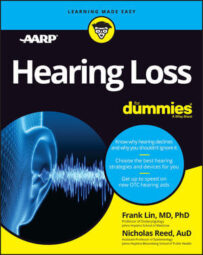It’s also a far cry from the mental image many people have when they picture hearing aids as large and bulky pieces of plastic that stick out from behind the ear connected to huge earpieces sitting in your ear canal.
Hearing aids come in several different shapes and sizes to customize the fit to the wearer. This article covers the broad-style categories but always remember that other variants exist and different manufacturers use different names. Generally, there are two main styles of hearing aids: behind-the-ear and in-the-ear. Each has some subtypes.
A good hearing aid fit is important to prevent that buzzing sound that is known as feedback. This happens when the amplified sound coming out of the hearing aid speaker is picked up again by the hearing aid microphone and reamplified.
Behind-the-ear hearing aids
Behind-the-ear hearing aids, often known as BTEs, are the most common style of hearing aid. It sits behind the ear — hence, the name — while a tube runs to the front of the ear where it connects to either an earmold or dome in the wearer’s ear canal, as shown in the figure below.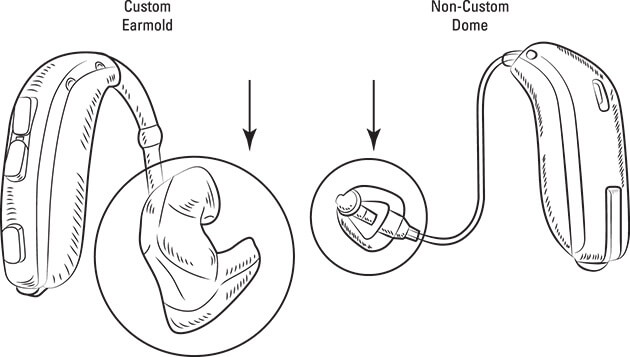 ©John Wiley & Sons, Inc.
©John Wiley & Sons, Inc.Earmold versus dome hearing aids
While earmolds are custom made to fit a wearer’s ear, domes are premade mushroom-shaped silicone pieces that come variety of sizes and designs to find the best fit for the wearer’s ear canal. BTEs have evolved into several subtypes, each with its own advantages and disadvantages.
Earmolds require a custom impression of your ear canal. There are at-home, do-it-yourself earmold impression kits, but we recommend you use these with caution. Improper use can leave silicone material in the ear which requires a professional to remove. When in doubt, see a hearing care professional to make your earmold impressions.
Traditional BTEs
The traditional BTE (see the figure below) houses all the components of the hearing aid (the microphone, amplifier, processor, and speaker) in a single space that sits behind the ear. It is connected to a custom earmold using flexible, medical-grade plastic tubing.The BTE is a fairly rugged product that provides ample space for more powerful hardware, which can accommodate the needs of any degree of hearing loss. There are even “power” models for profound hearing loss.
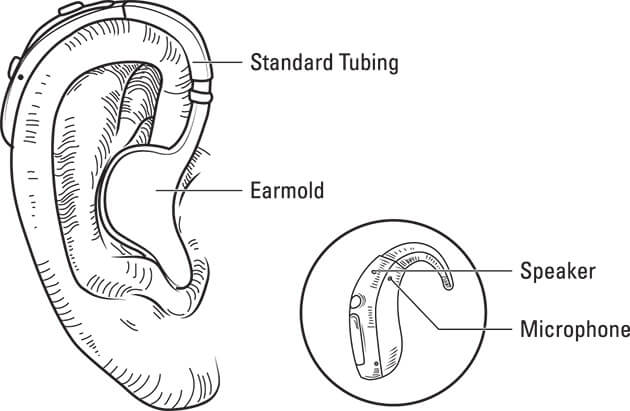 ©John Wiley & Sons, Inc.
©John Wiley & Sons, Inc.Traditional behind the ear (BTE) hearing aid. Note: All components (microphone, speaker, amplifier, and processer) are encased within the body of the hearing aid that sits behind the ear. Amplified sound travels from the hearing aid through the tubing and earmold to the ear canal.
While the traditional BTE is the most versatile of hearing aid design, it has not always been perceived as the most discrete, so engineers have come up with newer versions of the BTE: slim tube and receiver-in-the-canal BTEs.
Slim tube style BTEs
Like the traditional BTE, the slim tube BTE (see the figure below) also houses all the components of the hearing aid behind the ear, but it uses much smaller tubing for a more discrete look.Rather than using a larger custom earmold that fills up the ear, slim tube BTEs use a dome or smaller custom earmold that sits deeper in the ear canal. The smaller size limits the slim tube style to mild to moderate hearing losses. In some cases, the slim tube style can work for severe hearing loss, but it is pushing the boundaries of this style’s capabilities.
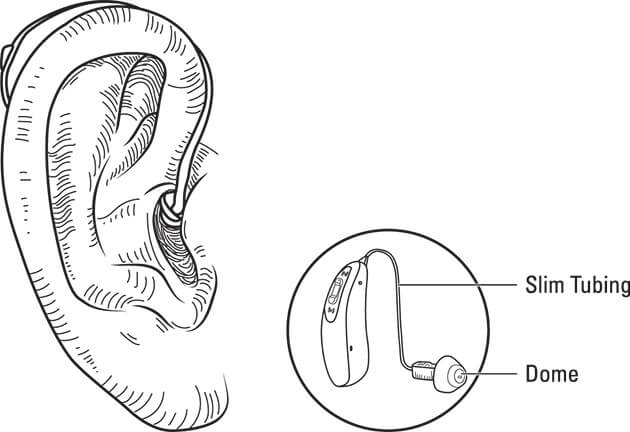 ©John Wiley & Sons, Inc.
©John Wiley & Sons, Inc.Slim tube hearing aid. Note: Like the traditional BTE, all components are encased within the body of the hearing aid; amplified sound travels through the slim tubing to the ear canal.
Receiver-in-the-canal style BTEs
With a newer receiver-in-the-canal (RIC) BTE (see the figure below), the receiver or speaker sits in the dome or small earmold in the wearer’s ear canal and is connected to the body of the hearing aid behind the ear via a wire. This means that the signal output is being delivered right into the wearer’s ear rather than having to travel through tubing from the hearing aid body sitting behind the ear.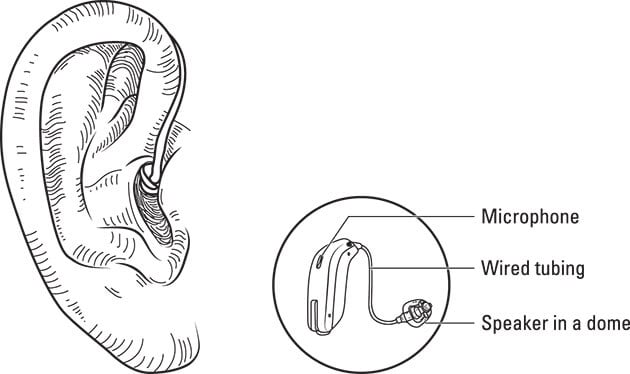 ©John Wiley & Sons, Inc.
©John Wiley & Sons, Inc.Receiver-in-the-canal hearing aid. Note: In this model, the speaker is now in the dome so amplified sound does not travel through any tubing but rather is delivered directly into the wearer’s ear canal.
This style may result in a clearer, crisper signal and can reduce feedback. Its design is smaller and more discrete. The major drawback to this style is that the receiver and wire are delicate and require regular maintenance and a gentle touch to avoid becoming damaged easily.
Open and closed styles
Slim tube and RIC styles often use domes rather than custom earmolds for the part that sits in the ear canal. These domes can be open or closed fit, which refers to whether the domes have holes in them (open fit) or not (closed fit).People with milder, high-frequency hearing losses can use open fit domes, which allow for more natural sound to enter the ear canal and allow for the ear canal to breathe. Conversely, closed fit domes are used for more moderate or severe hearing loss as they block outside sound and amplify low-frequency sounds.
Open domes help prevent the occlusion effect — that is, when your ears feel plugged up and your voice sounds louder to you with an echo-like quality. You might also refer to this sound quality as “hollow” or “booming.” This happens because when we move our jaw to speak or chew, we create vibrations in the ear canal. When the ear canal is completely blocked with a hearing aid or earmold, those vibrations can’t escape and result in the occlusion effect.
People who have better low-frequency hearing and use closed domes, earmolds, or ITE-style hearing aids are more likely to report experiencing the occlusion effect. Should you run into this issue, check with your hearing professional. Fun fact: You can simulate the occlusion effect by repeating words and sentences aloud with and without your fingers plugging up your ear canal (alright, maybe not that fun).
In-the-ear hearing aids
With in-the-ear hearing aids, also known as ITEs, the entire device sits in the wearer’s ear (see the figure below). These devices are custom made and require an earmold impression to be sent to a manufacturer.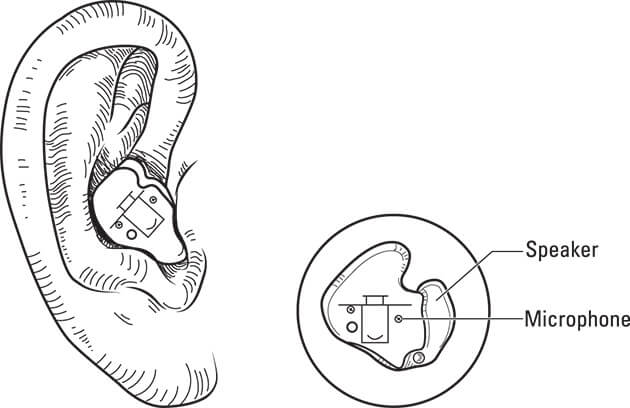 ©John Wiley & Sons, Inc.
©John Wiley & Sons, Inc.In-the-ear hearing aid. Note: The amplifier and processor are encased within the body of the hearing aid just behind the microphone.
Popular smaller variants of the ITE are referred to as completely-in-the-canal (CIC; see the figure below). These styles are even smaller and, as the name implies, sit deeper in the ear canal. In fact, the CIC is essentially invisible and so small it requires an attached removal handle to get it in and out of the ear canal.
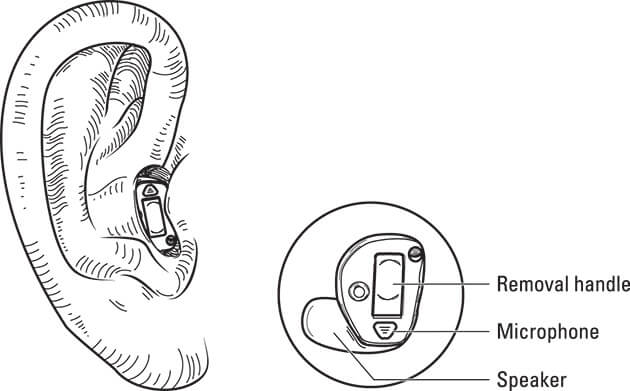 ©John Wiley & Sons, Inc.
©John Wiley & Sons, Inc.Completely-in-the-canal hearing aid. Note: The amplifier and processor are encased within the body of the hearing aid just behind the microphone.
The primary purpose of the CIC is cosmetic. A major drawback is that the small size comes at the expense of power. These small hearing aids are intended for mild hearing loss and cannot address the needs of more moderate or severe loss.
The size of the CIC also limits the features available; CICs often can’t use advanced technology features like directionality. Some users who choose these styles become disappointed in their hearing aids and believe them to be ineffective when, in reality, these people have been fit with a hearing aid that is inappropriate for their level of hearing loss or hearing needs.
ITEs are a great option when the user has problems inserting and manipulating behind-the-ear–style hearing aids due to numbness in their fingers or arthritis. The custom shape of the ITE makes it somewhat easier to slip into the ear.
Pros and cons of hearing aid styles
Picking the right hearing aid for you requires checking out the pros and cons of each style of hearing aid. Take a look at the table below to see which style may be the one for you.
Hearing Aid Styles Pros and Cons
| Type | Used For | Pros | Cons |
| Traditional behind-the-ear | All degrees of hearing loss from mild to profound | Extremely versatile device with widest range of available features | Relatively larger in size and most visible to the eye |
| Slim tube behind-the-ear | Mild to moderate hearing loss with some flexibility to fit severe hearing loss depending on the specific device | Less visible than traditional BTE and can use open domes for more natural sound | Requires enough dexterity to manipulate smaller size than traditional BTE and doesn’t meet the needs of most severe and profound hearing losses |
| Receiver in the canal behind-the-ear | Mild to moderate hearing loss | Smallest BTE, clear sound from placement of speaker in the ear | Most fragile BTE |
| In-the-ear | Mild to severe hearing loss | Custom fit that is easiest to use when wearer has limited dexterity | Smaller size may limit a few features |
| Completely in-the-canal | Mild hearing loss | Nearly invisible | Small size limits power and features like directionality |

